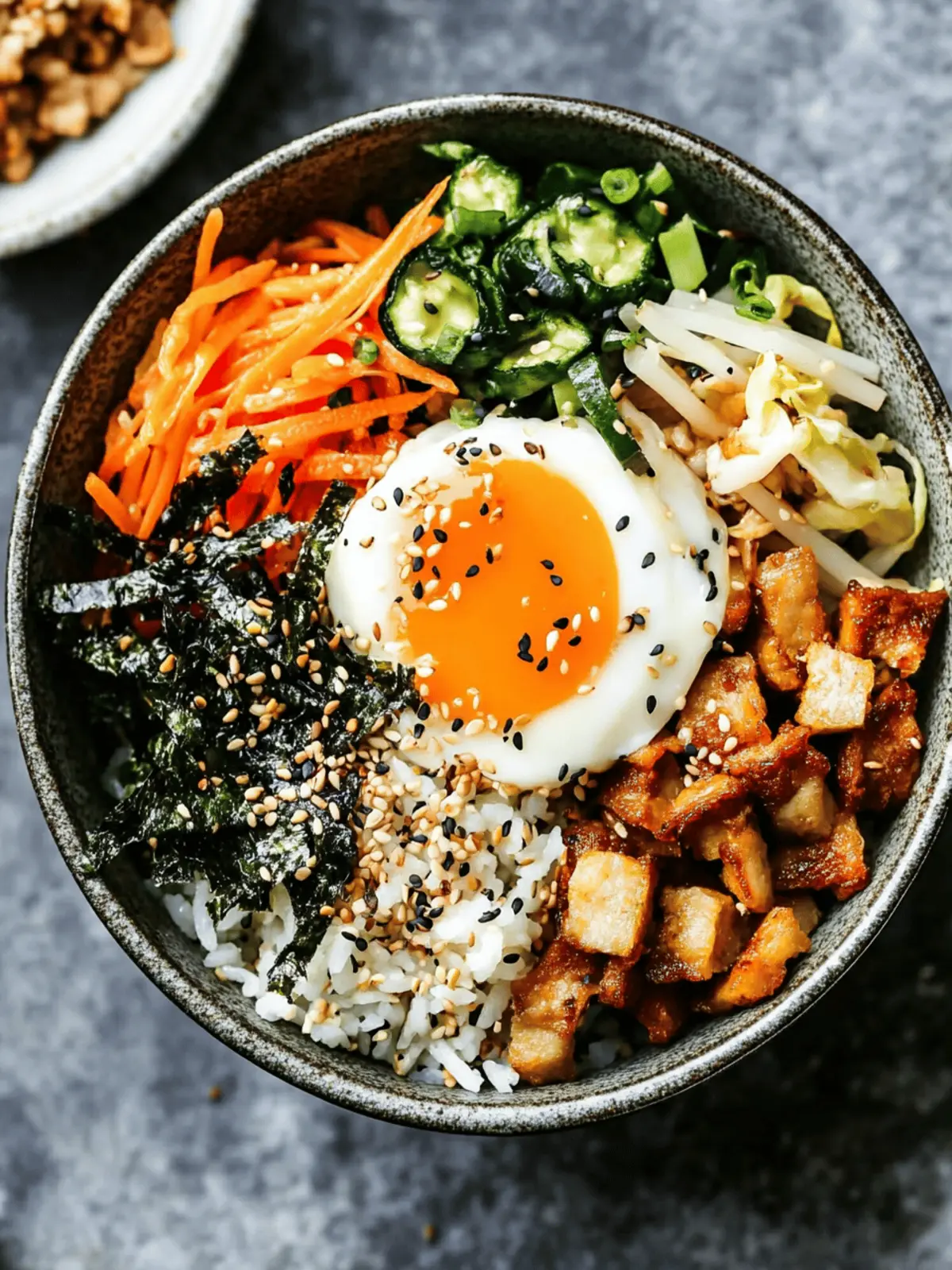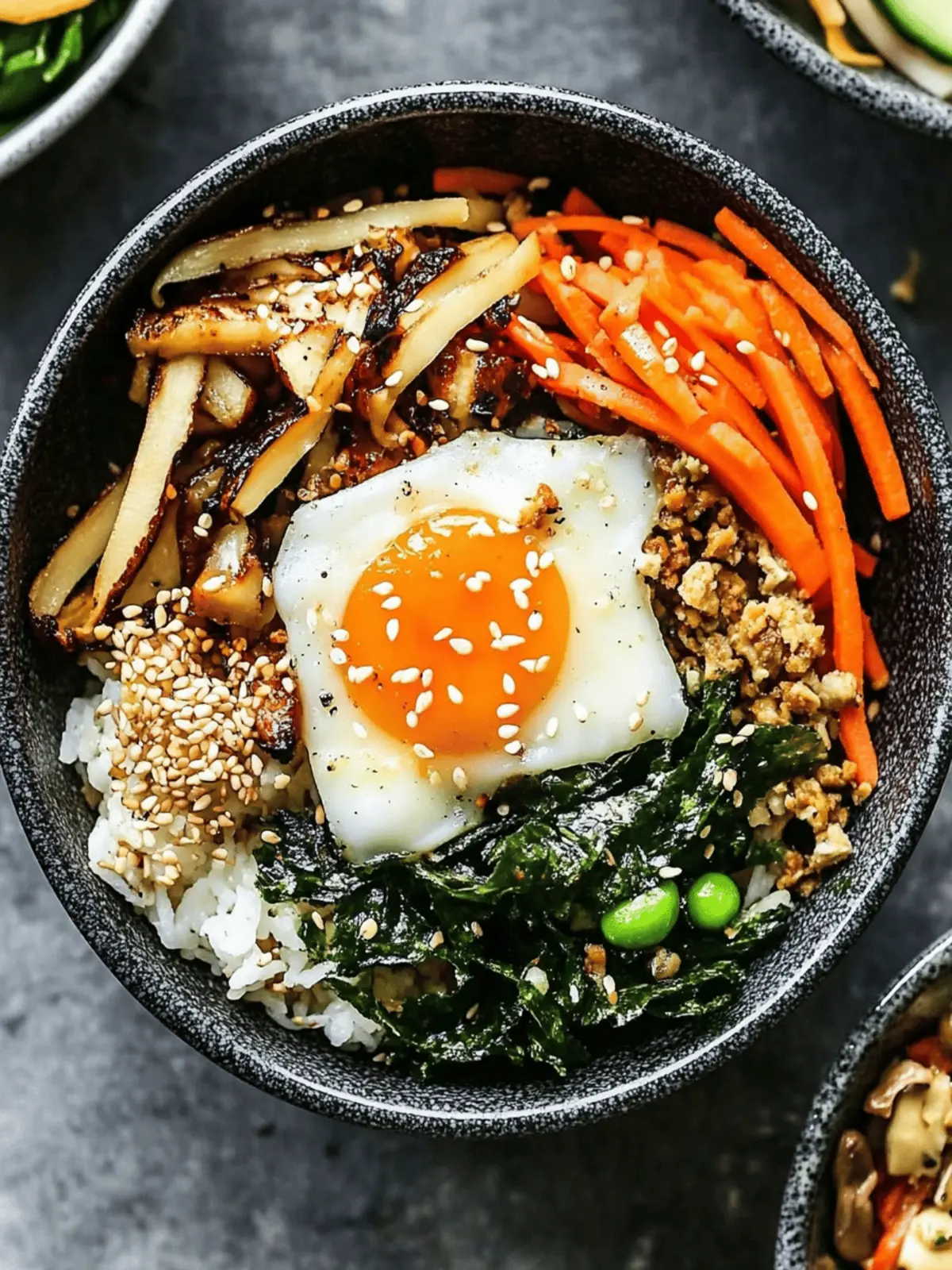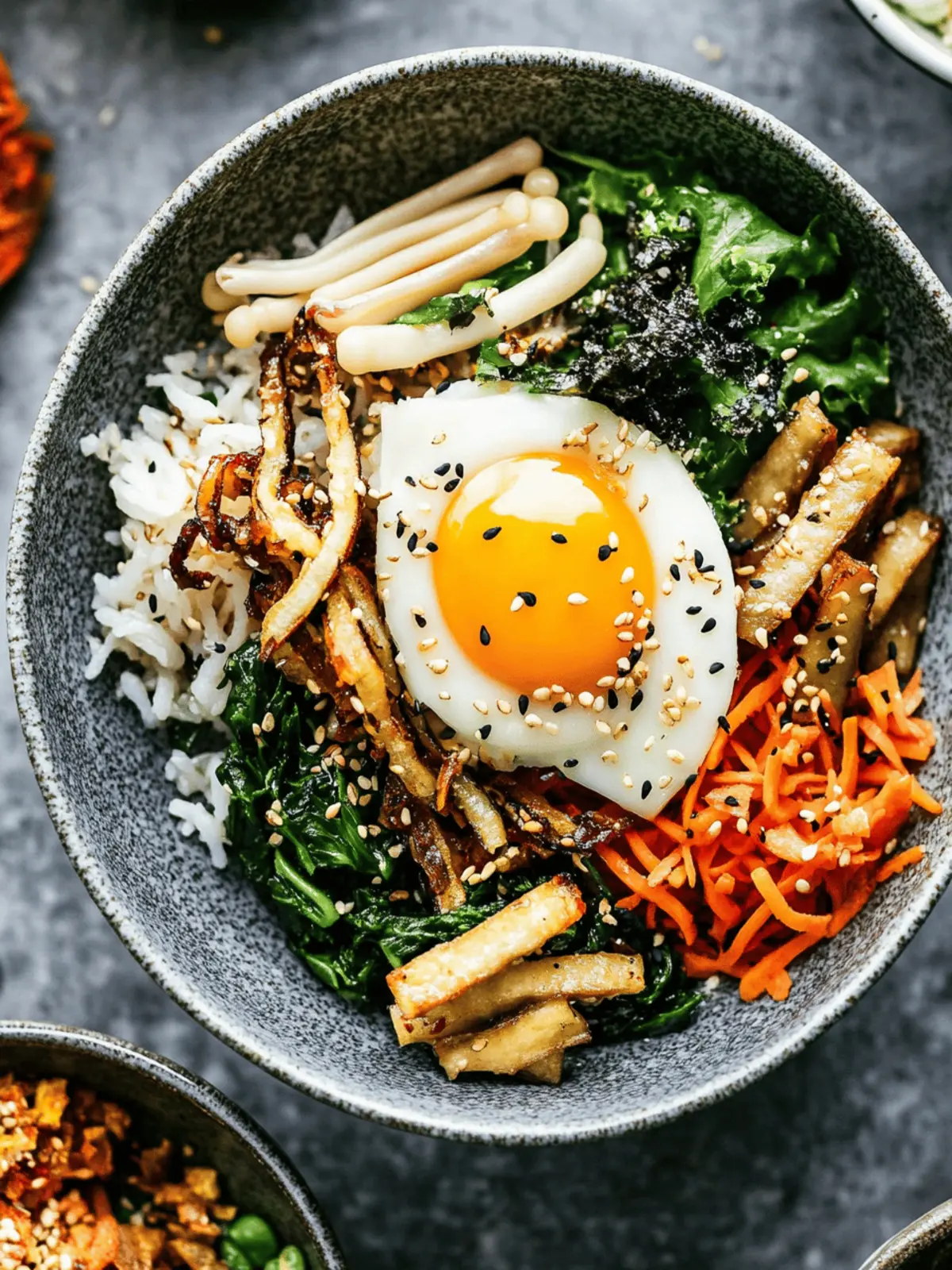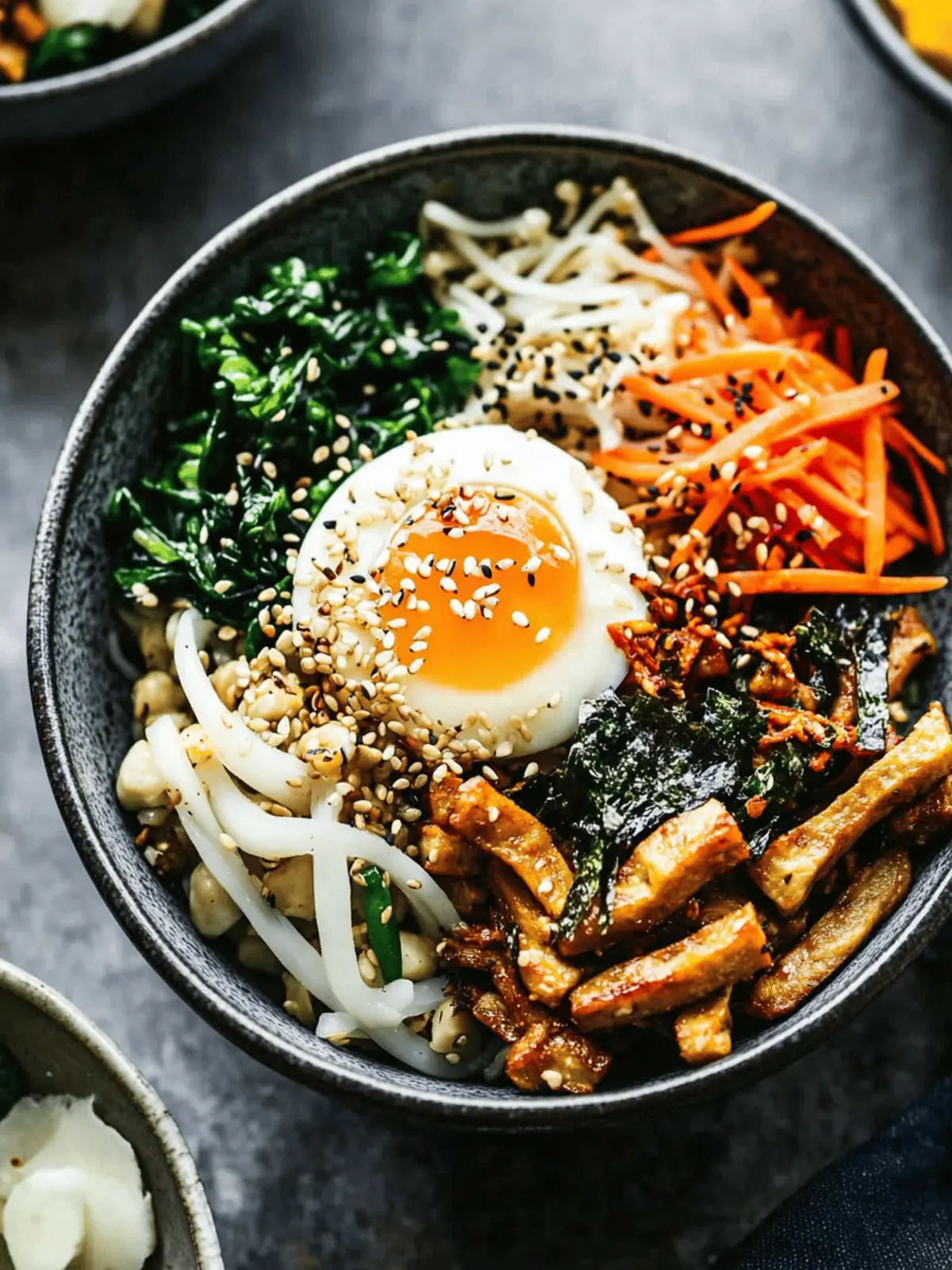There’s something truly special about the vibrant colors and textures that come together in a bowl of Vegetarian Bibimbap. When I first tried this Korean classic, I was captivated by the delightful contrast between crispy tofu and fluffy quinoa, all enhanced by a medley of colorful veggies. This dish has a way of bringing comfort to a busy weeknight or transforming a casual gathering into a feast for the senses.
What I love most is its incredible versatility; whether you’re a seasoned chef or just starting out in the kitchen, Bibimbap can be customized to suit your taste. With its balance of flavors from the nutty essence of sesame oil to the spicy warmth of gochujang each bite transports you to a world where every ingredient shines. Join me in whipping up this healthy, delicious Vegetarian Bibimbap that not only satisfies but also nourishes the soul!
Why is Vegetarian Bibimbap a must-try?
Flavor Explosion: The unique combination of crispy tofu, fluffy quinoa, and colorful veggies creates a harmonious taste sensation that dances on your palate.
Customizable Delight: Tailor it to your preferences by swapping veggies or adjusting spice levels—perfect for every occasion!
Healthful Goodness: Packed with nutrients and plant-based protein, this dish is not only delicious but also nourishing.
Quick Prep: Ready in under 30 minutes, it’s ideal for busy weeknights or last-minute dinners that impress.
Visually Stunning: Every bowl is a vibrant masterpiece, making it a feast for the eyes as well as the stomach.
Dive into a world of flavor and creativity with this tasty Vegetarian Bibimbap that is bound to become a staple in your home!
- Ingredients
• • ## Vegetarian Bibimbap Ingredients - For the Tofu
- Crispy Tofu – Provides plant-based protein and a satisfying crunch; use firm or extra-firm tofu for best results.
- Low Sodium Soy Sauce – Adds umami flavor; substitute with tamari for a gluten-free option.
- Honey – Provides sweetness; can be replaced with maple syrup for a vegan version.
- Sesame Oil – Enhances flavor with a nutty aroma; toasted sesame oil is recommended for a richer taste.
- For the Vegetables
- Kale (or other greens) – Adds nutrition and color; can replace with spinach or Swiss chard.
- Bean Sprouts – Contribute a crunchy texture; substitute with shredded cabbage if unavailable.
- Minced Garlic – Infuses flavor; adjust the amount based on preference.
- Green Onions – Provide fresh flavor and crunch; include both white and green parts.
- Shiitake Mushrooms – Add depth and umami; other mushrooms like button can be used instead.
- Carrots – Provide natural sweetness; julienne or cut into matchsticks for best presentation.
- For the Base
- Cooked Quinoa – Serves as the base of the dish; can substitute with rice or farro for a different texture.
- Eggs – Serve as a protein-rich topping; can be omitted for a vegan dish.
- For the Garnish
- Toasted Sesame Seeds – A delightful garnish that adds texture; chopped nuts can be used as an alternative.
- Gochujang (Korean chili pepper paste) – Adds spicy depth; substitute with sriracha for a milder taste.
Prepare to indulge in a colorful and flavorful bowl of Vegetarian Bibimbap that will delight everyone at your dinner table!
How to Make Vegetarian Bibimbap
- Prepare Tofu: Start by draining and pressing the firm tofu to remove excess moisture for optimal crispiness. Cut it into cubes and sauté in a non-stick skillet until golden brown, usually around 8-10 minutes.
- Flavor Tofu: Once the tofu is crispy, toss it in low sodium soy sauce, honey (or maple syrup for vegan), and a drizzle of sesame oil. Let it cook for an additional minute to absorb the flavors.
- Blanch Kale: In a large pot, bring water to a boil and blanch the chopped kale for about 3 minutes. Afterwards, squeeze out the excess water and season with soy sauce, garlic, and sesame oil.
- Cook Bean Sprouts: Boil water and cook the bean sprouts until tender for 2-3 minutes; then, season them with a splash of soy sauce for extra flavor.
- Sauté Mushrooms and Green Onions: In the same skillet used for the tofu, sauté the white parts of green onions and shiitake mushrooms in olive oil for about 4 minutes, until they’re tender and fragrant.
- Sauté Carrots: Add the julienned carrots to the skillet with some sesame oil and minced garlic, cooking for another 2-3 minutes until they’re soft yet still vibrant.
- Fry Eggs: Finally, fry the eggs sunny-side up in a small pan just before assembling the bowls, ensuring the yolks are runny for added indulgence.
- Assemble Bowls: Start with a generous scoop of fluffy cooked quinoa as your base. Layer on the crispy tofu, blanched kale, sautéed mushrooms, cooked bean sprouts, and carrots. Finish it off with sesame seeds, the fried egg on top, and serve gochujang on the side.
Optional: Add a splash of fresh lime juice for a zesty finish!
Exact quantities are listed in the recipe card below.
Tips for the Best Vegetarian Bibimbap
- Crispy Tofu Secret: Ensure your tofu is well-drained and pressed to achieve the perfect crispiness when cooked; soggy tofu won’t deliver that satisfying crunch.
- Flavor Balance: Taste your dish as you go! Adjust the soy sauce and gochujang levels to achieve your preferred spice and umami balance in the Vegetarian Bibimbap.
- Fresh Veggies: Opt for seasonal vegetables to elevate the flavor and freshness of your bibimbap; they will make your dish more vibrant and appealing.
- Prep Ahead: Prepare your toppings and ingredients in advance to create a “bibimbap bar” for family or friends, allowing everyone to customize their bowls easily.
- Storing Leftovers: Keep leftovers in airtight containers for up to two days. Note that the crunchiness of the vegetables might decrease upon reheating, so enjoy them fresh if possible!
Vegetarian Bibimbap Variations & Substitutions
Feel free to get creative with your Vegetarian Bibimbap by trying out these exciting variations!
- Grain Swap: Replace quinoa with brown rice or farro for different textures and added nutrients. The chewy bite of farro really elevates the experience!
- Greens Galore: Switch out kale for spinach, Swiss chard, or even lettuce based on your preference. Each leafy green brings its own flavor profile, enhancing your dish!
- Extra Veggies: Add seasonal favorites like zucchini, bell peppers, or eggplant for more variety. Mix and match to discover delightful flavors in every bite!
- Spicy Upgrade: Add kimchi as a topping for an extra punch of flavor and heat. The fermented crunch complements the freshness of the dish beautifully.
- Mushroom Mix: Experiment with button, portobello, or even oyster mushrooms for unique textures and tastes. The diversity of mushrooms can truly transform your bibimbap!
- Nutty Touch: Incorporate slivered almonds or crushed peanuts as a garnish for added crunch and a nutty flavor. It adds a delightful surprise in every mouthful!
- Egg Alternatives: For a vegan version, simply omit the egg or use scrambled tofu for a protein boost. There’s no shortage of delicious options to keep it plant-based!
- Sweet Kick: Swap honey for agave syrup or coconut nectar for a vegan-friendly sweetness that still shines through. A small change can make a big difference!
These variations ensure that this Vegetarian Bibimbap recipe stays fresh, exciting, and customizable for everyone at the table!
How to Store and Freeze Vegetarian Bibimbap
- Room Temperature: Enjoy your Vegetarian Bibimbap fresh during the first meal. It’s best served warm, so avoid letting it sit out for more than 2 hours.
- Fridge: Store leftover portions in airtight containers for up to 2 days. Reheat gently in a skillet, adding a splash of water to help restore moisture and texture.
- Freezer: For longer storage, freeze portions of the cooked quinoa and vegetables (without the egg) in airtight containers for up to 3 months. Thaw in the fridge before reheating.
- Reheating: To retain freshness, reheat your Vegetarian Bibimbap in a skillet over medium heat, adding a little water if needed to prevent sticking. Best enjoyed warm!
Make Ahead Options
These Vegetarian Bibimbap bowls are fantastic for meal prep! You can prep the quinoa, sautéed vegetables, and crispy tofu up to 3 days in advance, storing them separately in airtight containers in the refrigerator to maintain their freshness. To prevent the veggies from losing their crunch, sauté them just until tender, and avoid overcooking. When you’re ready to enjoy your meal, simply reheat the quinoa and tofu in a skillet, and slightly warm the veggies if desired. For a finishing touch, fry the eggs fresh right before serving; this way, you’ll retain their perfectly runny yolks, making your bibimbap just as delicious and satisfying as when it was first made.
What to Serve with Vegetarian Bibimbap?
Elevate your meal with delightful accompaniments that bring out the best in this bowl of flavor and comfort.
- Cucumber Salad: A refreshing mix of cucumber, vinegar, and sesame oil that adds a cool crunch. Perfectly balances the warmth of the bibimbap!
- Miso Soup: A light and umami-rich soup that complements the bold flavors of the bibimbap, providing a soothing element to your dining experience.
- Kimchi: This traditional fermented side dish adds a spicy, tangy kick that enhances the overall flavor profile, making every bite even more exciting.
- Steamed Edamame: Lightly salted and packed with plant-based protein, edamame provides a satisfying bite that pairs beautifully with the bibimbap’s textures.
- Sesame Dumplings: Soft, flavorful dumplings filled with veggies or tofu offer a delightful, chewy contrast to the crispy tofu and quinoa.
- Sweet Potato Fries: Crispy and slightly sweet, these fries create an enjoyable combination of textures and flavors next to your comforting bibimbap.
- Chilled Green Tea: A refreshing drink that cleanses the palate, apple hot tea is a fantastic way to contrast the dish’s spiciness and enhance the dining experience.
Vegetarian Bibimbap Recipe FAQs
How do I select the best tofu for my bibimbap?
Absolutely! For the crispiest results, you should use firm or extra-firm tofu. Look for tofu that feels solid and has minimal moisture; this will help achieve that satisfying crunch. If you can, choose organic tofu for better flavor and quality!
How should I store leftover Vegetarian Bibimbap?
Very! Store leftover portions in airtight containers, in the refrigerator for up to 2 days. When you’re ready to enjoy it again, gently reheat in a skillet over medium heat, adding a splash of water to maintain moisture and texture. This way, your leftovers stay flavorful!
Can I freeze Vegetarian Bibimbap?
Absolutely! To freeze, separate the cooked quinoa and vegetables (without the egg) into airtight containers and store for up to 3 months. When you’re ready to eat it, thaw in the fridge overnight, then reheat in the skillet for the best texture. It’s a great meal prep option!
What can I do if my tofu isn’t crispy?
Oh dear, soggy tofu can be a letdown! To avoid this, be sure to drain and press your tofu properly before cooking—this removes excess moisture. Cook it on a hot skillet with enough oil until it’s golden brown, usually around 8-10 minutes. Flipping it halfway will help achieve even crispiness!
Are there any dietary considerations for this recipe?
Very! If you have dietary restrictions, simply substitute ingredients as needed. For a gluten-free option, use tamari instead of soy sauce and skip the egg for a vegan version. Additionally, feel free to swap veggies based on personal preferences or to accommodate allergies there are plenty of delicious options!
How can I ensure my bibimbap has a vibrant color and flavor?
Great question! Using a variety of seasonal, fresh vegetables not only enhances presentation but also boosts flavor. Think about adding ingredients with contrasting colors like red bell peppers, yellow zucchini, or purple cabbage. Sauté these colorful veggies just until tender this helps retain their beautiful hues!

Delicious Vegetarian Bibimbap with Crispy Tofu You’ll Love
Ingredients
Equipment
Method
- Drain and press the firm tofu to remove excess moisture. Cut into cubes and sauté in a non-stick skillet until golden brown for about 8-10 minutes.
- Toss the crispy tofu in low sodium soy sauce, honey (or maple syrup for vegan), and a drizzle of sesame oil. Cook for an additional minute.
- Blanch chopped kale in boiling water for about 3 minutes. Squeeze out excess water and season with soy sauce, garlic, and sesame oil.
- Boil water and cook the bean sprouts until tender for 2-3 minutes. Season with a splash of soy sauce.
- Sauté the white parts of green onions and shiitake mushrooms in the same skillet for about 4 minutes.
- Add julienned carrots to the skillet with sesame oil and minced garlic, cooking for 2-3 minutes until soft.
- Fry the eggs sunny-side up, ensuring the yolks are runny.
- Assemble bowls with a scoop of cooked quinoa and layer with crispy tofu, blanched kale, sautéed mushrooms, bean sprouts, and carrots. Top with sesame seeds and fried egg, serving gochujang on the side.








